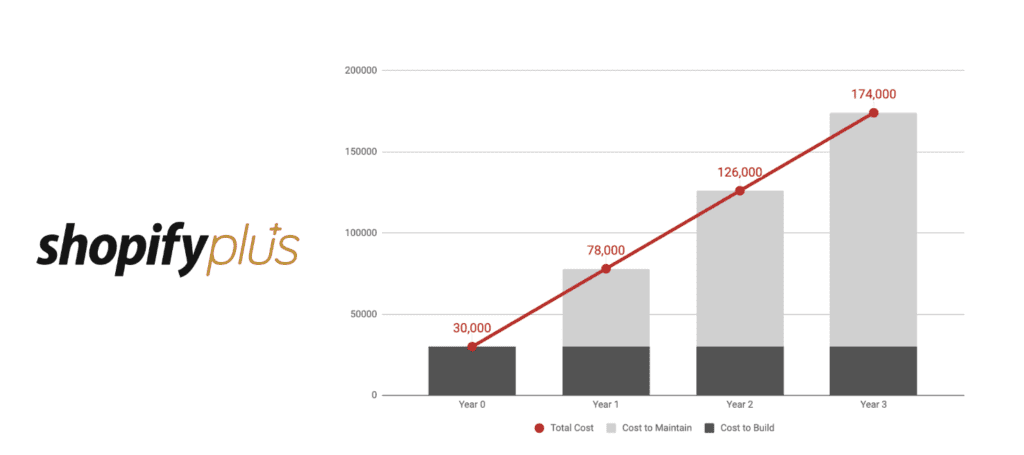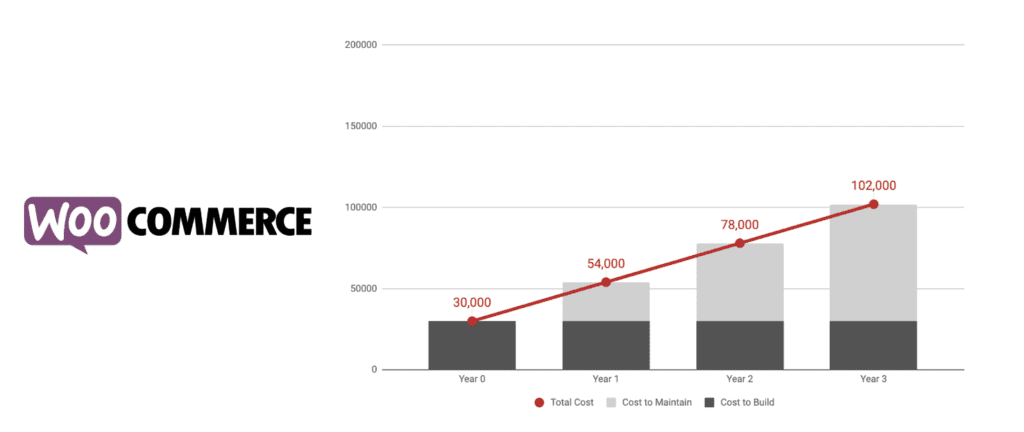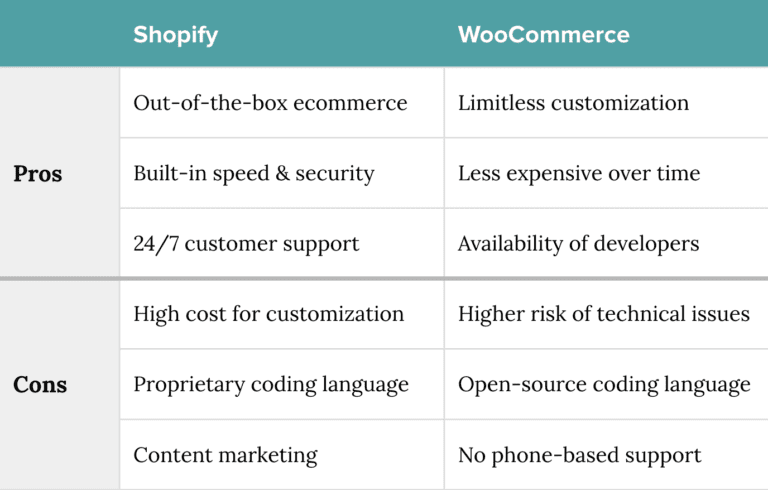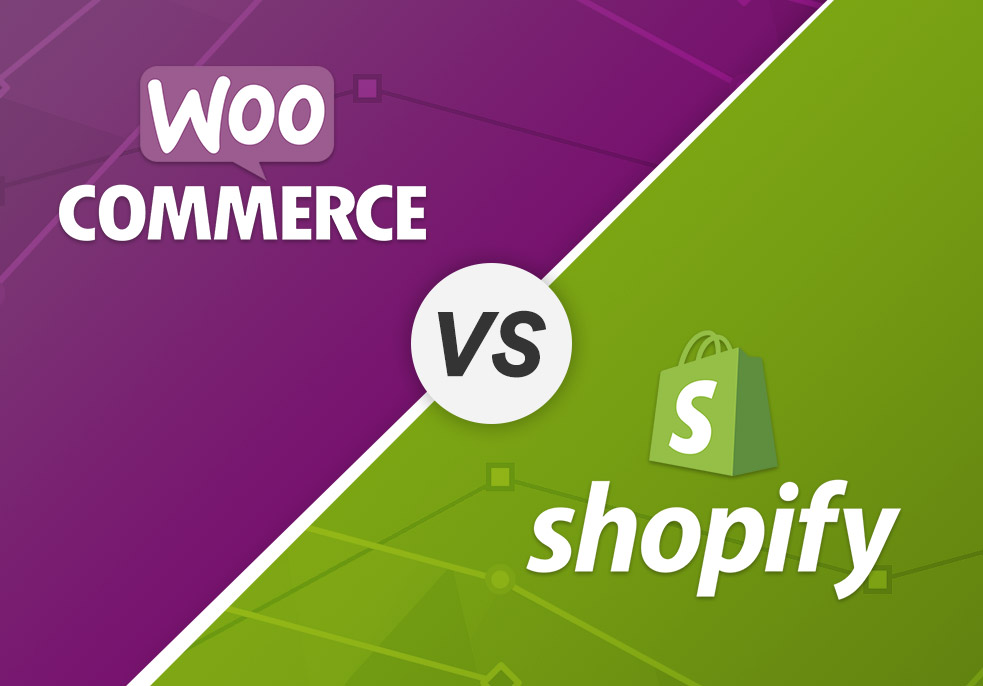If you’re a startup or an established brand without a strong ecommerce presence, we would recommend two main choices for running your online store – Shopify and WooCommerce.
Both are fine choices, and they each have situations where they are most appropriate. But we definitely have a preference between the two, and it probably isn’t the one you think.
Before we dive deep into the details, let’s first run through some of the basics. We are making the assumption that your ecommerce business is in the lower mid-market, doing revenues somewhere between $1 million and $10 million in sales each year.
Here’s a more thorough breakdown of the fixed and variable costs associated with the two services.
Cost Overview of Shopify Plus vs. WooCommerce
Shopify Plus Costs

Fixed Costs (Cost to Build)
- Design + Development = $30,000
Variable Costs (Cost to Maintain)
- Developer Maintenance Costs = $2,000/month
- Domain + Hosting Costs = $2,000/month
First Year Cost = $78,000
Annual Cost After Development = $48,000
WooCommerce Costs

Fixed Costs (Cost to Build)
- Design + Development = $30,000
Variable Costs (Cost to Maintain)
- Developer Maintenance Costs = $2,000/month
- Domain + Hosting Costs = $200/month
First Year Cost = $55,200
Annual Cost After Development = $26,400
It’s critical to consider not only the upfront cost of a ecommerce site build, but also the cost to maintain the website depending on the platform. For example: Despite an equal cost to build, a Shopify site may wind up being the more expensive option due to higher maintenance costs.
What is Developer Maintenance Costs?
You might be wondering about the “Developer Maintenance Costs,” and whether that’s necessary for your website. The answer is, yes, it absolutely is… unless you’re a professional developer. On average, online retailers spend about 7% of their online revenue on supporting and maintaining their ecommerce systems. The monthly retainer that we use for all of our ecommerce clients offers 20 hours of work for $3,000.
This ultimately saves you money as you have people on call to keep your online store running smoothly, and you’re also investing in improving functionality over time. So, to sum up, if you need a presence that is customized in any way, and you want to save money, WooCommerce is definitely the better option.
However, what if you’re just getting started with an ecommerce presence, and you want to limit your initial costs, that might change.
Why is Shopify Plus On-Going Costs More Expensive than WooCommerce?
Remember, of course, that these are the costs to BUILD the site – that’s not factoring in the annual savings of not paying Shopify Plus’s minimum rate of $2,000 month subscription fee for your custom theme!
There are several ways to increase AOV, but it usually stems from one of two things:
- Customers purchase more items
- Customers buy higher priced item(s)
If you can do either one of these things, you will be able to increase your AOV, and consequently, your total revenue.
With that in mind, let’s look at how to influence customer behavior in order to increase AOV in your WooCommerce store.
Why is WooCommerce More Customizable than Shopify?
Typically there is a plugin or app for the majority of use cases that ecommerce websites run into.
If there’s not, you can either build it yourself or hire a WooCommerce expert (like, say, SG Web Partners) to build it for you.
This removal of constraints is a key differentiator from Shopify. If the nature of your ecommerce business requires something a bit different from the general shopping cart experience, WooCommerce may give you a platform that you can shape to meet your needs.
Reasons to use Shopify
Shopify is about as simple as it gets. You don’t need to worry about hosting servers, or backend stuff like ssl certificates and server upgrades. Shopify take care of all of this for you. Shopify’s basic plan starts at $14.99 per month, and is designed to scale with you. Many enterprise ecommerce websites with sales in the millions continue to use Shopify, such as Kylie Jenner (shoutout to Kylie being a billionaire).
That’s why we recommend Shopify for small or new businesses, or Shopify Plus for larger businesses with no current ecommerce presence. If you have no existing website, and you don’t have any intention of building one, then the starter Shopify plan is a great option.
On top of your monthly costs, you will spend money on a Shopify theme and apps from the Shopify app store.
Why use a Shopify theme?
A Shopify theme allows you to personalize your shop’s appearance.
If you are not a developer or hiring a quality Shopify development expert, I would highly recommend purchasing a pre-built theme.
A solid Shopify theme typically costs between $100 and $200.
For a one-time investment of $200, and then under $200 annually, you’re getting a world class ecommerce platform.
But that’s if you’re looking at a pre-designed, off-the-rack Shopify Theme. Not a custom designed Shopify theme from a developer.
Why use Shopify apps?
Shopify apps allow you to extend the functionality of your store. You may use an app to add customizable options on your product page, integrate with your email marketing provider, or add a popup.
There are over 2,900 apps on the Shopify app store.
As a Shopify development agency, we see our customers typically paying $25 to $100 per month for Shopify apps.
Looking to supercharge your Shopify store? See the list of the best Shopify apps.
Reasons to use WooCommerce
Regular readers of this blog will know we are especially fond of WooCommerce. In a few short years WooCommerce has become one of the most popular ecommerce platforms in the world.
Based on data from Built With, 22% of the top 1 million sites using ecommerce technologies are using WooCommerce. That’s more than both Shopify and Magneto.
If you already have a WordPress site in place and have experience managing websites running WordPress, WooCommerce is an excellent starting point for both small and medium ecommerce websites with intermediate and expert ecommerce fluency.
Not convinced? You may be surprised that ecommerce brands such as Branch Basics are on Woocommerce.
It’s true that this is a bit higher than the costs for the entry-level Shopify plan. But with the Shopify plan, your options are highly restricted, while WooCommerce gives you customization flexibility and freedom from the outset. Remember, of course, that these are the costs to BUILD the site – that’s not factoring in the annual savings of not paying Shopify’s $2,000 a month subscription fee for your custom theme!
And speaking of which, let’s talk about the specifics of WooCommerce themes.
Here’s a more thorough breakdown of the Pros/Cons associated with the two services.
Pros and Cons of Shopify and Woocommerce

Shopify/Shopify Plus
Shopify is a great platform for users that want to start their own website by themselves (Shopify), or for those who want to do a lot of advanced customizations (Shopify Plus). Unfortunately the middle ground between the 2, doesn’t leave a lot of room for customizations.
Pros
- Lots of functionality with their B2B/Wholesale system
- Hosted ecommerce software
- Takes care of the technical maintenance of running a store for you
- Scalable ecommerce platform
- Quality support 24/7
- Do-it-yourself friendly
- Robust set of features right out of the box.
- Much better marketing and name recognition
Cons
- Cannot do a wholesale/B2B site with normal Shopify Plans (Basic, Normal, Advanced), need to do Shopify Plus ($2,000/month)
- Without Shopify Plus, you need to know coding to customize/make edits extensively
- Proprietary coding language to learn if you want to make significant edits
- Have to pay $2,000/month to have access to their B2B/wholesale capabilities
- More expensive than WooCommerce when customized
- SEO: If you have a blog or existing web presence, you will likely need to host on WordPress anyway – which means your WordPress and Shopify presences are split. This is disastrous for SEO and Google search ability.
- Good Shopify developers are expensive, and many lack the skill set needed to make highly customized edits
- Hosted service has limits to what you can and cannot customize, even at the highest service tiers
WooCommerce/Wordpress
WooCommerce is an open-source ecommerce plugin for WordPress. It is designed for small to large-sized online merchants using WordPress. A study conducted in 2017 shows that WooCommerce stores collectively account for nearly $10 billion in sales.
Pros
- Limitless customization with relatively little added cost
- Can easily create a new B2C site and sync the inventory
- Less expensive for most businesses
- Our experience building it, will save you time/money
- Unified website/blog/store presence provides powerful SEO
- Saves money over time (far less hosting/maintenance fees than Shopify)
- Best user experience for the end user (because we can customize it to your needs)
- Availability of Developers: WooCommerce is based on WordPress/PHP, one of the most popular development platforms in the world. There is never any trouble finding a developer for anything you need.
- Greater functionality – While WooCommerce doesn’t necessarily have all the features Shopify has right out of the box, the rich development environment ensures that there is a plugin, or a way to create one, to solve ANY problem.
Cons
- Breaks more easily if the site is poorly coded
- No phone-based customer support – only support via submitting tickets
- This problem is mitigated by having a good developer and a maintenance retainer!
- Weak marketing – WooCommerce is a open-sourced platform, and so doesn’t have a marketing machine to tout its own virtues
- Requires a skilled developer – poor coding can expose security and functionality flaws in the site
- Again, be sure to get people who can build your site the RIGHT way from the outset, and these drawbacks cease to exist!
Ecommerce Design and Development Case Studies
Shopify Case Studies
BoomBoom (aired on Shark Tank)
This wellness company needed a beautifully-designed ecommerce website to support their appearance on the popular TV show Shark Tank.
The launch of Piff’s new digital storefront has enabled this reseller sneaker and streetwear company to consistently drive online revenue & increase profitability.
WooCommerce Case Studies
This outdoor apparel company required both a B2C and B2B ecommerce website with the ability to integrate everything with their inventory management system.
Branch Basics creates high-quality cleaning products made from non-toxic, powerful multi-use cleaning concentrate that will solve all of your household cleaning needs without sacrificing your health.
Summary
As you can see there are a lot of factors to consider when deciding between WooCommerce versus Shopify. It definitely can be overwhelming if you are just starting out, especially because not everything with running your online store is a one-size fits all answer. Hopefully, the cost breakdown and the pros and cons above help get you further along! Did we miss any important tips or perhaps you have questions? If so, let us know below.

Thank you for providing this comparsion between woocommerce and shopify. This would be useful for those who don’t know what is this two website or who are starting to uses this websites. It is really a very useful and informative article.
Thank you sharing this articles.
Great post aboutthe comparison between shopify and woocommerce.. I am also a developer and would like to recommend shopify.
Nice and very informative post you have been written. i also prefer shopify for ecommerce websites.
Thanks for sharing about the comparison between shopify and woocommerce.. I am also a developer. I will recommend shopify. I have used it on many ecommerce sites.